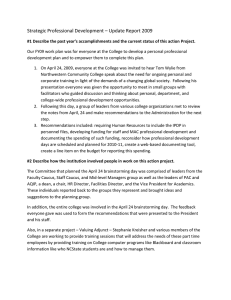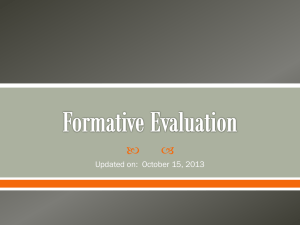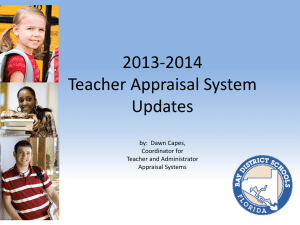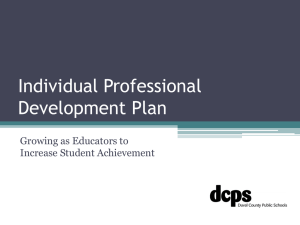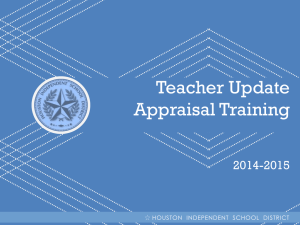INDIVIDUAL Professional Development PLAN
advertisement
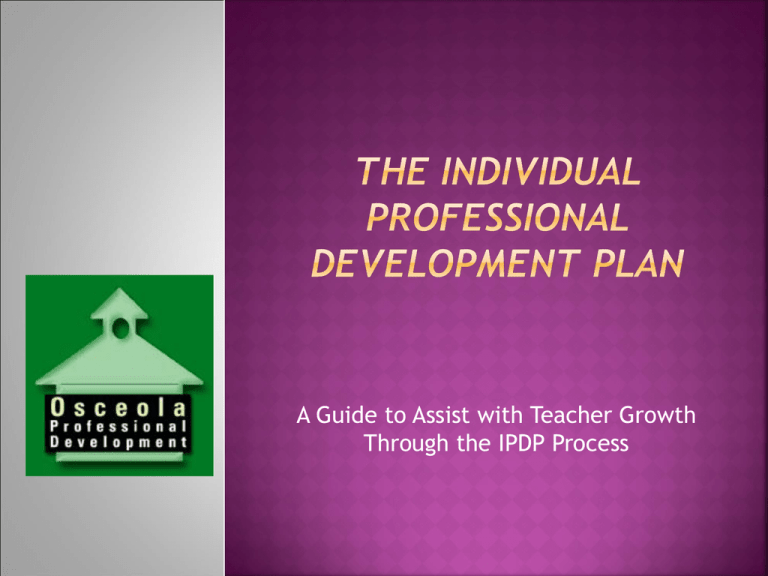
A Guide to Assist with Teacher Growth Through the IPDP Process “The only way we can improve our schools is people.” Dr. Richard DuFour “When you talk about school improvement you are talking about people improvement.” Ernest Boyer •Participants will be able to create an Individual Professional Development Plan (IPDP) to enhance their performance and make even greater gains in the classroom. • Define Action Research • Identify data about their own performance and that of their students and use that data as part of an action research plan (IPDP) • Identify appropriate sources of data to process monitor • Identify appropriate benchmarks of performance from which they can make personal decisions about their teaching performance • Maintain the plan throughout the plan period • Determine outcomes of the action research used as part of the IPDP process What is Action Research? Action research is a model of professional development that promotes collaborative inquiry, reflection, and dialogue. “Within the action research process, educators study student learning related to their own teaching. It is a process that allows educators to learn about their own instructional practices and to continue to monitor improved student learning” (Rawlinson & Little, 2004 Emphasis Added). Your IPDP is your tool for Action Research FLORIDA STATUTE 1012.98(5) 5. Require each school principal to establish and maintain an individual professional development plan for each instructional employee assigned to the school as a seamless component to the school improvement plans developed pursuant to s. 1001.42(18). The individual professional development plan must: a. Be related to specific performance data for the students to whom the teacher is assigned. b. Define the inservice objectives and specific measurable improvements expected in student performance as a result of the inservice activity. c. Include an evaluation component that determines the effectiveness of the professional development plan. TEACHER PERFORMANCE STUDENT ACHIEVEMENT What are my areas to manage? Review your previous year(s) class data. Ask yourself these important questions: Where have I noticed that my students have struggled academically most in the past? What are skills, concepts or strands associated with that performance that my students have not seemed to master? What data do I have to support that? What have always been my greatest struggles with students in terms of classroom management? What does my data show? What single thing, that if I did it exceptionally well, would make the greatest impact on my students? Why do I think so? Do I have data that supports that? Are there patterns of poor student performance for the past several years? As we know, student achievement is directly correlated with teacher effectiveness. If there is a section of FCAT or even a chapter test on which a teacher’s students seem to score poorly, then this is an area where the teacher can do a pretest on current students. Trust yourself, but look at the data. If the data (FCAT, teacher tests, report card data, etc. or other measure) shows that your students have historically not done as well on fractions – you have identified the problem. You may also use data from your previous Instructional Performance Assessments (evaluations). New Teachers can use data from their student’s past performance on standardized tests, report cards, attendance, etc. Identify and focus on one area for improvement in student performance. You have identified the problem, and now you need a way to measure the student outcomes that result from the changes in instruction that you implement. You must ask yourself the question: What type of diagnostic or screening tool can I use to determine baseline data now and growth data later? Administer the tool/instrument to your current students to determine your baseline. Summarize the data for your students Teachers will need to access the EMPLOYEE PORTAL in order to create their IPDP online. The location of the EMPLOYEE PORTAL is: http://employees.osceola.k12.fl.us The opening page of the Employee Portal looks like this: On the left hand side of the Employee Portal opening page you will see IPDP listed. After you click on IPDP you will see the following display: Move your cursor over Your IPDP and click once. This is the next screen you will see: You will click here to begin filling in your IPDP information. In the block above you will enter the problem statement and the data used to determine the baseline. (For example, 38% of the students were able to recognize the basic parts of speech as measured by XYZ Publisher’s Grade 6 pre-test for Language Arts) In this block enter the improvement goal – it must be specific and indicate measurable improvements expected in student performance as a result of inservice activity and the timeline for their completion. For example – 90% of the students will be able to recognize the basic parts of speech by February 2009 as measured by the XYZ Language Arts Post Test Relationship to school improvement plan Your improvement goal must relate directly to one or more of the School Improvement goals. In this block you must tell how your individual goal relates to the school-wide plan. In this block enter the Professional Development Activities. The Professional Development in your plan should focus on one of the following: Sunshine State Standards Subject Content Use of Technology Teaching Methods/Instructional Strategies Assessment and Data Analysis Classroom Management School Safety Parent/Community Involvement “Professional Development is a journey not a destination.” In the next block enter the Classroom Strategies/Activities. Enter the classroom strategies that you are using to achieve your goals. The teacher and Administrator will meet to review the plan as required by statute and at that point agree on the implementation of the plan. The next step in the process is to begin implementation – attend training, implement the new strategies you have learned through the training and research and to monitor the progress. Progress monitoring is essential to reaching our goals. For instance, if you were driving from Florida to California and you had never done that before, your goal would be to drive to California and arrive safely. Along the route, you would check the signs and the map to make certain you were on track to reach your goal of California. It doesn’t make any difference if you are able to drive 100 mph if you are heading in the wrong direction. You are making great time, but will never reach California. The same is true in the classroom. You have to check your progress along the way. Teams may decide to meet over the course of the plan to discuss progress. Reflect on the strategies that you are using to achieve your goals and the results. It’s best to list these as you implement. This makes it easier for you in the end and makes the IPDP a living document for you. The teacher and Administrator will meet at the close of the plan to review the plan and the results. Like an Olympic athlete, reaching the finish line does not mean the end of running – just the end of that race.
